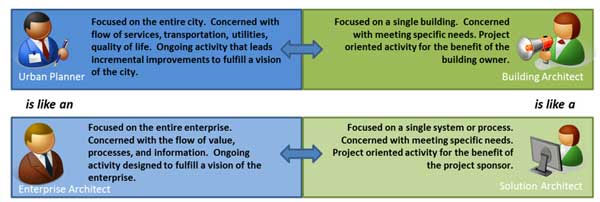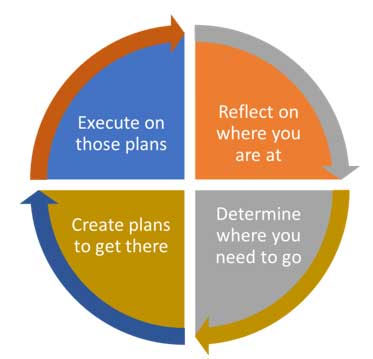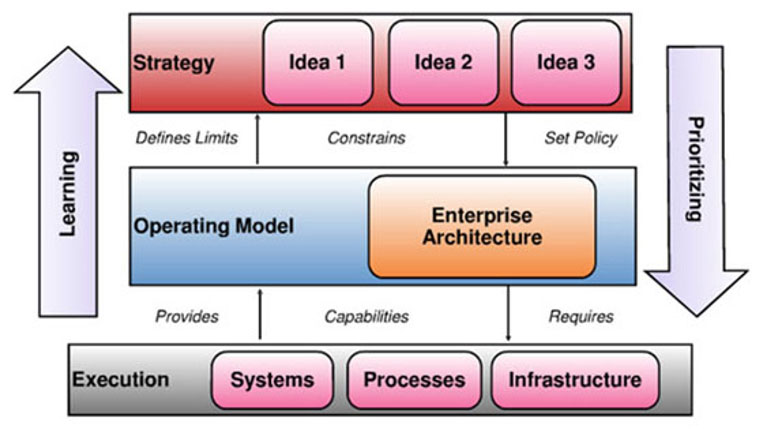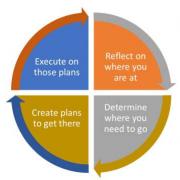Traditional views of strategy alignment share the perspective of providing guidance and direction within an organization by using a top-down approach, where upper management constructs and devises a strategy for the organization and this strategy is passed “downward” to the operational personnel. Although there is an implied understanding that the information gathered from operations should be used to update and enhance senior management’s perspective on the productivity, growth, and health of the organization, there has not been a lot of explicit instruction on how best to facilitate this exchange of communication within an organization. In fact, most traditional alignment models do not address how direction from the top gets translated and put into operational use; instead, the problem is ignored. The lack of a pragmatic approach for linking strategy to execution is a big hole in traditional alignment models.
There are many reasons for the failure of an organization to bring its strategies to life. Escalating complexity and rapid change have made the development and execution of effective strategy increasingly difficult (see Alignment: Using the Balanced Scorecard to Create Corporate Synergies). The field of enterprise architecture has rapidly evolved to address these challenges. EA is a well-defined practice for conducting enterprise analysis, design, planning, and implementation, using a holistic approach at all times, for the successful development and execution of strategy. EA applies architecture principles and practices to guide organizations through the business, information, process, and technology changes necessary to execute their strategies. These practices utilize the various aspects of an enterprise to identify, motivate, and achieve these changes.
Enterprise architecture uniquely fosters dialogue to create shared meaning and to deliver shared goals. The primary purpose of describing the architecture of an enterprise is to provide the holistic information and insights to effectively frame the opportunities of the organization and make better informed decisions. With EA, organization leaders can more readily improve the effectiveness, efficiency, and responsiveness of their enterprise. Effective EA is the key to enabling the enterprise to address orders-of-magnitude increases in complexity and orders-of-magnitude increases in the rate of change.
As shown in Figure 1, in many respects, EA professionals are the urban planners for the enterprise.

 Figure 1 — EA professionals as urban planners.
Figure 1 — EA professionals as urban planners.
The term “enterprise architecture” has various uses. In some cases, EA practices may focus on the outputs (“the noun”) rather than the practice of EA. A growing number of EA professionals use the term “enterprise architecture” to refer to a practice (“the verb”) rather than outputs or deliverable artifacts. Practitioners find that focusing on EA as a continuous practice allows EA guidance to evolve in response to the desire for particular business outcomes (see Figure 2). A continuous process provides clarity for the ongoing transformation of an enterprise.

Figure 2 — The general EA process.
The notion of EA as a continuous process is required to produce the enterprise information needed for the assessment and understanding of changes to the enterprise capability map and core business capabilities that is done as part of an annual governance process associated with the alignment of IT and the core business capabilities. This type of ongoing assessment of core business capabilities is critical to maintaining alignment between IT and the core business capabilities. As outlined earlier, this alignment is a central component in the effective execution of business strategy. As Figure 3 suggests, EA can be an effective bridge between strategy devised by senior management and the tactical execution level of the organization.

Figure 3 — EA can be the linchpin to bridge the strategy to execution. (Adapted from Enterprise Architecture as Strategy by Jeanne W. Ross, Peter Weill, and David Robertson.)
[For more from the author on this topic, see “Business Capabilities in Business/IT Alignment and Cultivating the Value of EA, Part I.”]



